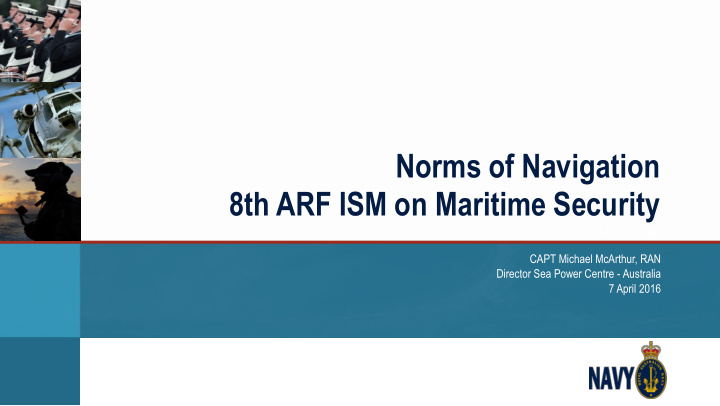



Norms of Navigation 8th ARF ISM on Maritime Security SUBTITLE LINE CAPT Michael McArthur, RAN Director Sea Power Centre - Australia 7 April 2016
Scope of Presentation • Maritime Security and The International System • Norms of navigation • Innocent passage • CUES
Maritime Security Underpins Prosperity Overview
The Concept of Maritime Security Our concept of maritime security is informed… By our common history n By its connection to prosperity n By its implications for the international system n While our nations’ policies may not always align… We must find a way to work together on maritime security n The international system of norms, standards, rules, and laws should represent those areas n where our nations’ policies do align Building capability, capacity, and trust is fundamental to increasing security n Areas for cooperation in maritime security
Areas for Cooperation in Maritime Security UNCLOS • International Organization Development • Piracy • Illegal, Unreported, and Unregulated Fishing • Refugees and Migrants • Maritime Domain Awareness • The Role of Coast Guards •
The International System
The Building Blocks of the International System
The Building Blocks of the International System
Norms of Navigation • Freedom of navigation • Innocent passage • Code for Unplanned Encounters at Sea (CUES)
Freedom of Navigation All ships have a freedom of navigation of the high seas under Article n 87(1)(a) of the Law of the Sea Convention This guarantee is also applied to the exclusive economic zone of a n state by Article 58 Only the waters of the territorial sea and internal waters of a coastal n state have restrictions of freedom of navigation Special navigational regimes guarantee rights of access to the n territorial sea
Innocent Passage Available in the territorial sea • Must be continuous and expeditious (18) • Stopping or anchoring are possible where: • – incidental to ordinary navigation • – rendered necessary by force majeure or distress • – rendering assistance to persons, ships or aircraft in danger or • distress Can be temporarily suspended for essential security purposes, but not • discriminate, and be published in advance (25(3))
CODE FOR UNPLANNED ENCOUNTERS AT SEA • Commonly referred to as CUES • Publication of the Western Pacific Naval Symposium • Endorsed by the Chiefs’ Symposium in Qingdao, China on 23 April 2014
Development of CUES • On behalf of WPNS, the Australian Chief of Navy promulgated a draft of CUES in 1999 • There have been various revisions since then • A major review in 2013, conducted by a team of four nations and coordinated by Australia • Renamed the document • Simplified the legal sections • Clarified its application to ‘naval ships and aircraft’ • Updated the annex (tactical component) • Reformatted the document with a modernised ‘new look’
PURPOSE OF CUES • CUES provides navies with safety procedures, a basic communications plan and basic manoeuvring instructions for naval ships and naval aircraft during unplanned encounters at sea
Legal Considerations • CUES is not legally binding – nations will use it voluntarily • Naval ships and aircraft enjoy sovereign immunity • CUES does not supersede international civil aviation rules or rules applicable under international agreements or treaties or international law
Safety Procedures • Actions to avoid collisions at sea • Formations and convoys • Safe speeds and distances • Radio communication procedures
Challenges Ahead • Training • Implementation • Exercises and real life experiences • Document review
Recent Developments Endorsed by IONS Conclave of Chiefs in Dhaka, Bangladesh on 13 • January 2016 France is proposing a WPNS CUES Working Group – to be • considered at WPNS 2016 in Padang, Indonesia on 13 April 2016 Singapore is proposing the development of an underwater CUES, to • be discussed at the 2 nd Submarine Operational safety Conference, in Busan, Republic of Korea on 30 May 2016 The US Coast Guard adopted CUES in late 2015 and are encouraging • other coastguards to follow suit
www.navy.gov.au
Recommend
More recommend